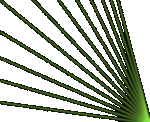|
Several images can be
written down on the same hologram, which have different angles of supervision and,
therefore, they will occur one after another while hologram move (the multi-channel hologram). It is already used in group
portraits shooting.
On the hologram, as however, on a photo, several images can be recorded, but in a photo
all of them merge in one plane, in the hologram they can be separated in space. This
technology was already used in experiments on artistic holography, where object was placed
behind the curtain of water drops.
Using optical transformations, it is possible to carry out conform transformation of the
images of objects, and we can suppose, that there will be opportunities to record objects
with such transformations. It is possible to do it in a usual photography, but on
three-dimensional media these opportunities will reach another amazing level.
 |
This image is property
of Yves Gentet's studio
"Ultimate Holography". |
Here
are some words about colour. The
colour in holography is generated completely otherwise,
than in a photo. Colour on a photo is generated
by special colour paints, that are not reliable
enough at present. Therefore it isn't desirable
to keep photos under a light. Besides, all colour
schemes, based on colour separation are not ideal
(when real colour is simulated by a set of some
three colours, sometimes with the additive fourth
- black). The experts on colour schemes know, that
any device based on colour separation, including
a TV set or colour printer, can not display correctly
all set of colours. There are no paints in the hologram. The colour
hologram is made on a usual holographic black-and-white
photoplate. The colour is formed here because of
interference of white light on spatial system of
interference strips and layers. Therefore colour
hologram does not fade and, theoretically, should
not have restrictions on quality of colour presentation.
At present, technology of colour holography has
not left yet limits of experimental laboratories,
but there is a hope, that in the coming years it
will become more accessible.
Holography as a fine art
Only theoretically
hologram can display any real or virtual object. But technology of hologram manufacturing,
not to speak about the future holograms, synthesized in the supercomputer, extremely binds
the hologram with real objects.
If we talk about
holography of flowers or compositions, then the area of creativity here is in the work of
the master of composition, but hologram acts only as a perfect recorder.
If we talk about
portrait holography, it is possible to name this work as art, because the artistic result
is determined just by art of shooting, and there is no trivial recording of already
existing reality.
The opportunity to
record several images located at different supervision angles and at different sites in
volume of the hologram, has become the powerful creative tool in holography.
Artistic holography is
in the beginning of its way and its opportunities are not completely opened. Artists in
many holographic studios think out the fantastic projects, which sometimes require the new
decisions of technologies and equipment, and that is driving force of a science.
Holography as the art shows itself as synthesis of an optical science and art creativity,
in which many creative plans require joint work of the scientists, designers and artists.-->
|





